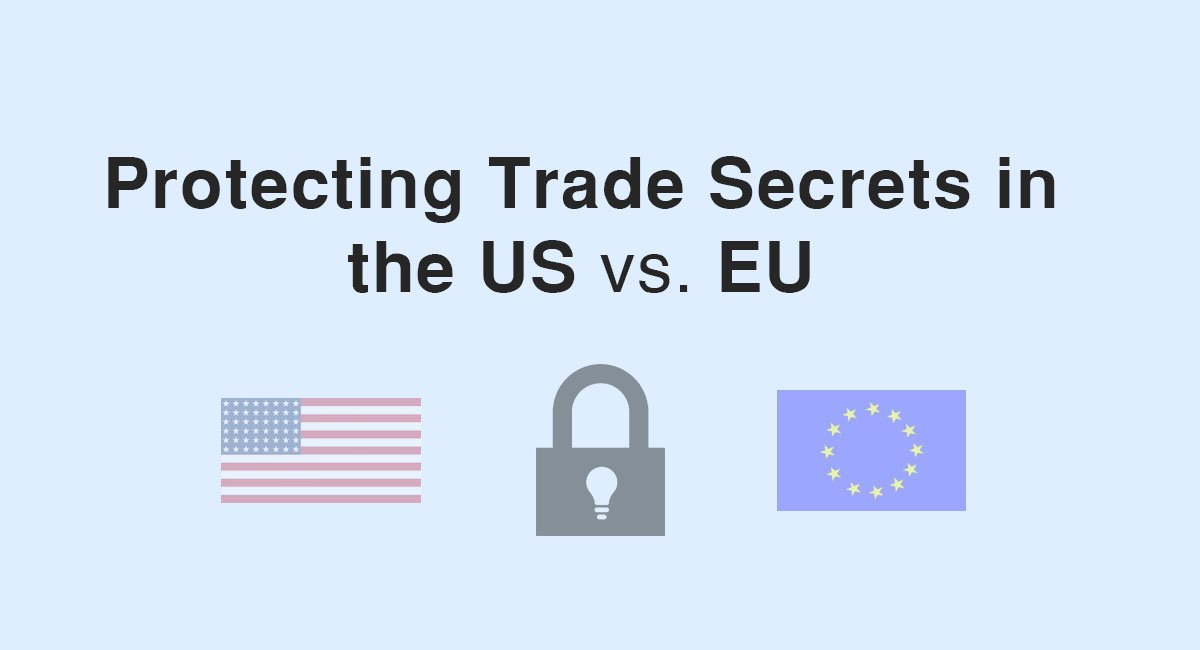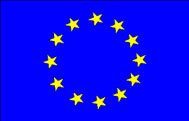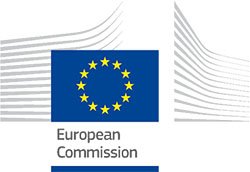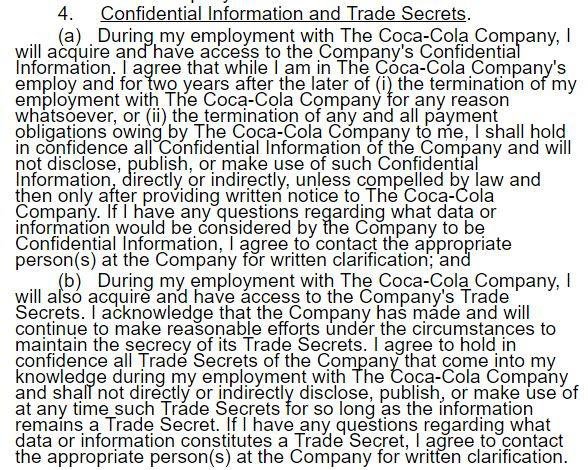Protecting Trade Secrets in the US vs. EU

Trade secret misappropriation has become a large problem in our society today due to the ease of accessing confidential information online, the rise of hackers and intentional economic espionage activities.
Plus, we have more efficient copying methods such as smartphone cameras and photocopiers which make it easy to copy something with a click of a button. Trade secrets refer to information that provide a business with significant competitive and commercial advantage.
This can include technical secrets such as:
- Processes
- Recipes (like Coca Cola’s formula)
- Patterns
- Prototypes
- Programs
- Commercial secrets such as customer and supplier lists, cost and pricing information

The largest international trade secret agreement between countries is The Agreement on Trade Related Aspects of Intellectual Property Rights (TRIPS).
In principle, the 159 member countries agree to a common definition of trade secrets. Additionally, TRIPS state that natural and legal persons shall be entitled to their trade secrets not being unlawfully exposed, acquired or used without their consent in a manner contrary to honest commercial practices.
Trade Secrets in the US

The US is a member of the World Trade Organization (WTO) and TRIPS. Prior to May 2016, the US provided some protection for trade secrets through state lawx.
Most of the states adopted the Uniform Trade Secrets Act which is similar to the language in TRIPS.

The state law enabled courts to protect trade secrets by giving courts power to order the following judgements against errant parties:
- Royalty payments.
- Damages.
- Court costs.
- Reasonable attorneys fees.
- Trade secrets confidentiality to be maintained.
However, unlike other types of intellectual property such as patents, trademarks and copyrights, trade secrets were not protected under federal law.
![]()
This was until the Defend Trade Secrets Act 2016 (DTSA) came into force on May 12 2016. According to the 2013 IP Commission report on the Theft of American Intellectual Property, trade secret misappropriation costs US businesses more than an estimated $300 billion annually.
The 2 most common avenues for theft of trade secrets occur through industrial and economic espionage, and cyber espionage.
An example is the attempted theft of DuPont’s secret chlorination production method by the Chinese. The DTSA was enacted to strengthen US’s existing trade secret protection by providing aggrieved parties with a choice to pursue litigation under federal as well as state law.
The act also is empowered to order ex parte seizures under special circumstances, as well as to order exemplary damages for up to two times the amount of monetary damages, if the court finds evidence of willful and malicious conduct by the defendant.
Here’s the 18 U.S.C. § 1836(b)(2)(A)(i) DTSA that allows ex parte orders “for the seizure of property necessary to prevent the propagation or dissemination of the trade secret.“:

Trade Secrets in the EU

Trade secret theft is also a problem in the EU. Faced with increasing global competition, usage of external consultants, offshore manufacturing and outsourcing, the EU has come to the realization that something must be done to protect EU businesses’ trade secrets.
Current existing trade secret protection varies considerably between EU countries and is not interchangeable due to a lack of an EU-wide legislation and differences in national laws.
For example, these countries have their own civil trade secret laws:
- Austria
- Bulgaria
- The Czech Republic
- Estonia
- Germany
- Finland
- Greece
- Hungary
- Italy
- Latvia
- Lithuania
- Poland
- Portugal
- Romania
- Slovakia
- Slovenia
- Spain
- Sweden
But these countries do not and instead, rely on judicial interpretation of contractual liability or traditional common law to protect trade secrets:
- Belgium
- France
- Ireland
- Luxembourg
- Malta
- The Netherlands
- UK
To add to the mix, Germany, Finland, Greece, Denmark and Spain don’t provide a definition of what constitutes trade secrets. In addition, Cyprus’ trade secrets are only protected by contract while France allows criminal punishment against employees for theft of manufacturing trade secrets specifically.
These fragmented and sometimes outdated national legal differences give rise to uncertainty and is reflected in a general reluctance of EU businesses to take legal action for trade secret violations.

A 2013 study prepared for the European Commission revealed that 1 in 5 European companies have experienced trade secret theft, or attempts at theft, at least once in the past ten years. 2 out of 5 European companies said that the incidences of trade secret theft has been increasing.
The study also found from its survey of 537 companies that companies were reluctant to seek redress against trade secret violations because:
- 42% found it difficult to meet legal requirements.
- 28% were deterred by a lack of effective remedies.
- 27% could not quantify damages.
This is worrying for both EU leadership and EU business owners, especially when 75% of the companies surveyed also found that trade secrets are important for maintaining their competitive-edge.
The European Commission also states that recent studies have shown that because of the differences in national laws in the EU on trade secrets:
- 82% of companies encountered higher business risk in EU countries with weaker protection.
- 59% of companies are less enthusiastic about doing cross-border research and development.
- 40% of companies hold back from sharing trade secrets because of the risks involved.
- Only 40% of companies have sought legal recourse for trade secret theft.
- At least 70% of companies support EU legislation for trade secret theft.

Fueled by these findings, the European Commission produced a proposal for a Directive in November 2013, proposing a clear set of rules for EU members to follow to provide fair and comparable access to legal action for trade secret thefts across the EU. These rules apply to:
- Misappropriation
- Use or disclosure of trade secrets without the consent of the owner and through dishonest means, illegal acts or breach of contract.
The European Parliament adopted its report based on the Commission’s proposal in March 2016 and the European Council approved the Directive in May 2016. The Directive must now be implemented by EU countries into their national laws within two years.
While it’s great that both the US and the EU are taking positive steps in the right direction to affirm the importance of trade secrets to provide better protection for businesses, what action can you take, as a business owner, to protect your own trade secrets?
How NDAs are used with trade secrets
As an owner of a trade secret, unlike copyright, you don’t have exclusive rights over the trade secret. If you’re reckless with it and it gets exposed to competitors, you have no legal right to stop your competitors from copying or even reverse engineering your process to discover your trade secret.
The legal protection afforded under the new US and EU legislation discussed earlier only apply when someone hacks into, steals, uses or exposes your trade secret without your permission and does this dishonestly, illegally or in breach of a contract with you.
It doesn’t apply where you have been reckless with the trade secret yourself. In other words, you lose your trade secret status and have no legal recourse when you have not taken reasonable steps to protect your trade secrets.
Reasonable steps can include:
- Creating an information security policy and procedure for your business in relation to the trade secret.
- Keeping the trade secret in a locked and secure area.
- Ensuring that anyone who has access to the trade secret has signed a legal agreement to keep confidentiality about it and not to misuse it.
- Restricting access to the trade secret only to select people who are bound by legal obligations to keep it secret.
- Keeping an updated list of the people who have access to the trade secret.
- Providing regular training to employees to ensure that they understand what a trade secret is and what are your company’s security policies and procedures.
- Marking the trade secret as “CONFIDENTIAL” or “TRADE SECRET” to lessen the risk of unintended exposure.
- Regularly reviewing your information security policy and procedure to ensure that they are still effective and being followed.
- Conducting exit interviews with employees who have had access to the trade secret and reminding them of their obligation of confidentiality, even after leaving your employment.
Of course, the best way to protect a trade secret is not to share it with others at all.
However, in reality, you’ll have to work with others and at some point, you probably have to share the trade secret with another person, even if it’s only with a trusted employee to get some work done.
This is where non-disclosure agreements (NDAs), also known as confidentiality agreements, are essential. NDAs are by far, the most important legal tool for protecting trade secrets.
Before sharing your trade secret, you should always use this type of legal agreement to place a legal obligation on the other party receiving your trade secret to keep it confidential. Here’s an example of a clause from a confidentiality agreement by Coca-Cola:

Unlike patents and copyrights with limited timeframes for ownership, trade secrets can last indefinitely. In other words, as long as you continue to take active reasonable steps to protect your trade secret and it provides you with commercial advantage for your business, you can continue to claim ownership of the trade secret.
Businesses like KFC and Coca-Cola have held onto their trade secrets for around 100 years. Because trade secrets have no expiry dates, it’s important that any legal protection that you choose for the trade secret has no expiry date either.
This is one reason why you need to tread carefully if you’re considering patent protection for your trade secret.

In the US for example, patent protection only lasts for approximately 20 years. After that, anyone can copy the patent and use it. If you want the trade secret to remain confidential for as long as possible, an NDA is a better bet.
You can create a perpetual NDA where the obligations of confidentiality for the trade secret do not expire. Note though, that the perpetual term of confidentiality should only apply to trade secrets and not to other ordinary confidential information (unless you have special rare circumstances for requiring such a long term of confidentiality). For example, in Coca-Cola’s agreement, they clearly differentiate between the time obligations of confidentiality for ordinary confidential information and trade secrets.
While the term of confidentiality for a trade secret is to last indefinitely, they have only imposed a two year term of confidentiality following termination of employment for ordinary confidential information.

NDAs are also great as a supplement for establishing and protecting intellectual property rights.
For example, if you were creating something that you eventually want to patent, you could use this legal agreement to keep your creation a secret while you work towards the patent.
Similarly with copyrights, trademarks and designs, you can also use the agreement to keep confidentiality until you’re ready to register those rights.
NDAs are not only extremely versatile, but they are vital to the survival of a trade secret, whether you’re based in the US or the EU.
If you don’t have one for your trade secret and you’ve already shared the trade secret with others, don’t wait any longer, get an NDA drawn up immediately.
Your trade secret’s survival status depends on it.
Nov 28, 2017 | Trade Secrets
This article is not a substitute for professional legal advice. This article does not create an attorney-client relationship, nor is it a solicitation to offer legal advice.